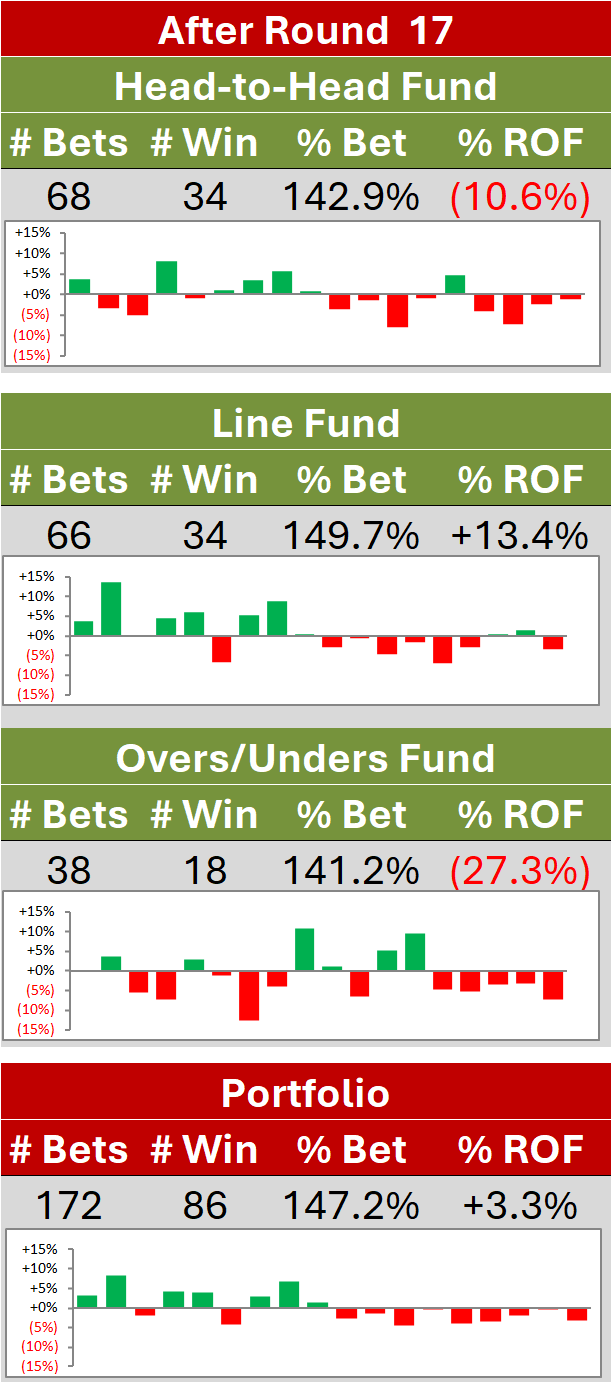The Value of MARS Ratings Points Across Time
/Which Teams Fare Better as Favourites?
/The Greatest Upset Victories in VFL/AFL History (1897-2012)
/Team MARS Ratings Performance By Decade and Overall: 1897 to 2012
/And the Best and Worst VFL/AFL Teams of All-Time Are ...
/Really Simple Margin Predictors
/Are the Victory Margins for Some Games Harder to Predict than for Others?
/Clustering Your Way To Line Betting Success : Building a Predictive Model
/Clustering Your Way To Line Betting Success
/Incorporating the Draw in Overround Calculations
/The Probability of a Draw
/One Margin Predictor To Rule Them All
/Yet Another Look at Bookmaker Overround
/Building Simple Margin Predictors
/Using Risk-Equalising Probabilities for the Margin Predictors
/With the exception of Combo_NN_2, all of the Margin Predictors rely on an algorithm that takes Bookmaker Implicit Probabilities as an input in some form:
- Bookie_3 and Bookie_9 use Bookmaker Implicit Probabilities directly
- ProPred_3 and ProPred_7 use the outputs of the ProPred algorithm, which uses a log transform of Bookmaker Implicit Probabilities as one input
- WinPred_3 and WinPred_7 use the outputs of the WinPred algorithm, which also uses a log transform of Bookmaker Implicit Probabilities as one input
- H2H_U3, H2H_U10, H2H_A3 and H2H_A7 use the outputs of the Head-to-Head algorithm, which uses Bookmaker Implicit Probabilities as one input
- Combo_7 uses Bookmaker Implicit Probabilities directly as well as via its use of the outputs of the Head-to-Head Algorithm
- Combo_NN_2 uses Bookmaker Implicit Probabilities directly as well as via its use of the outputs of the ProPred, WinPred and H2H algorithms
For this short blog I've switched, in all of the underlying algorithms, the Implicit Probabilities calculated using the Risk-Equalising Approach as replacements for those calculated using the Overround-Equalising Approach and then compared the resulting MAPEs for seasons 2007 to 2012 for all the Margin Predictors.
Overall, all Margin Predictors except Bookie_3 benefit from the switch, however modestly. Bookie_9, which now will serve as a co-predictor in the MAFL Margin Fund, benefits most, knocking over one quarter of a point per game off its MAPE.
The uniformity of these improvements is made slightly more remarkable by the realisation that the Margin Predictors, built using Eureqa, were optimised for the probability outputs of the underlying algorithms when those algorithms were using Overround-Equalising Implicit Probabilities. So, for example, the equation for Bookie_9, which is:
Predicted Home Team Margin = 2.2205129 + 17.729506 * ln(Home Team Bookmaker Probability/(1-Home Team Bookmaker Probability)) + 2*Home Team Bookmaker Probability
was created by Eureqa to minimise the historical MAPE of this equation when the Home Team Bookmaker Probabilities being used were those calculated assuming Overround-Equalisation. The 0.26 points per game reduction in the MAPE is being achieved without re-optimising this equation but, instead, simply by replacing the Home Team Probabilities with those calculated using a Risk-Equalising Approach.
Bookie_3 is the one Margin Predictor that responds poorly to the switch of probabilities without an accompanying re-optimisation in Eureqa. When I performed such a re-optimisation, Eureqa came up with this remarkably simple equation:
Predicted Home Team Margin = 21 * ln(Home Team Bookmaker Probability/(1-Home Team Bookmaker Probability))
This predictor has an MAPE of 29.22 points per game, which is extraordinarily low for such an easy-to-use predictor.
CONCLUSION
Virtually every algorithm used in MAFL has now been shown to benefit, however slightly, from using Implicit Probabilities calculated using the Risk-Equalising instead of the Overround-Equalising Approach. Naturallly, this makes me wonder if there's an even better way ...
Maybe next year I'll look for it.


